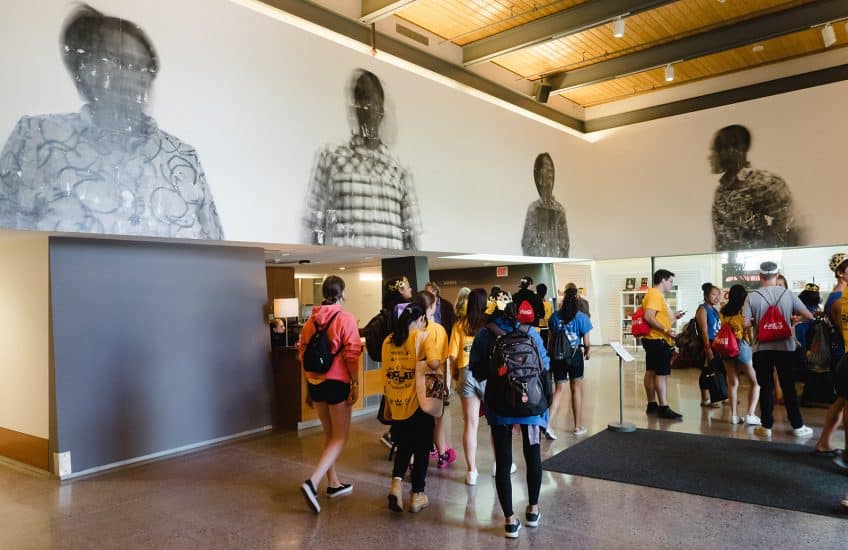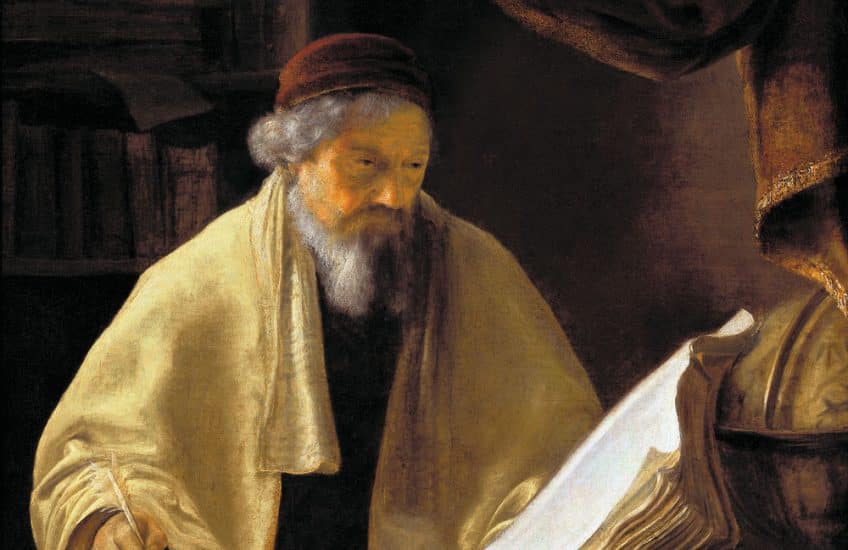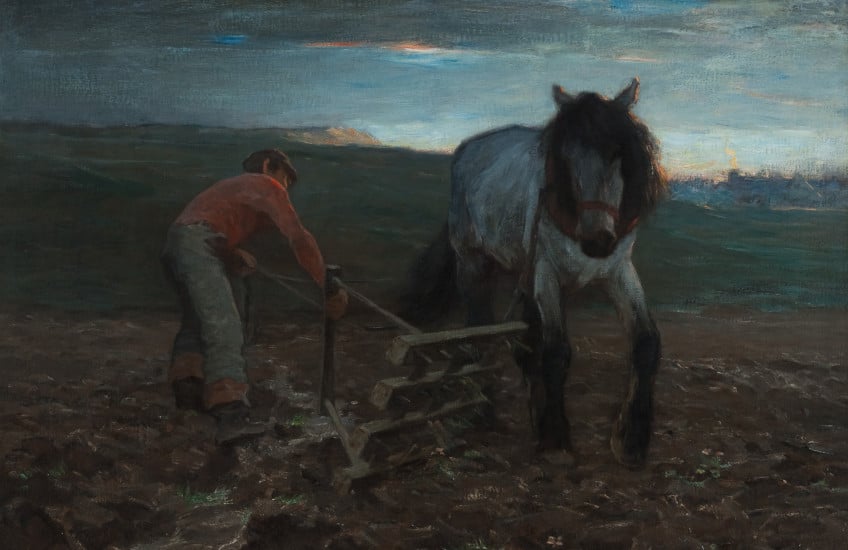
Suzanne van de Meerendonk: My name is Suzanne van de Meerendonk and I am the Bader Curator of European Art at the Agnes Etherington Art Centre at Queen’s University. In this Collection Highlight, we take a closer look at Elisabetta Sirani’s etching The Holy Family with Saints Elizabeth and John the Baptist. In this touching depiction of motherhood and kinship, we see the Virgin Mary nursing her son Jesus while playfully interacting with the infant Saint John the Baptist. John’s Mother, Saint Elizabeth, is seated right next to them winding the swaddling bands of the newborn Christ child. While most attention is given to the women and children, Mary’s husband Joseph can be seen in the background doing woodwork. Almost entirely covered in shade, his axe however gleams in the sunlight, ready to strike – a singular detail focused on hard, manual labor that draws contrast to the tender scene in the foreground.
Sirani’s etching was acquired by Agnes in 2018, and, dating to the 1650s, it represents the earliest work known to have been created by a female artist to enter our European art collection. Early modern Europe was a highly patriarchal society, and not many women were able to establish themselves as independent masters. As a result, collections of historic European art often count few artworks documented or signed by women artists. That does not mean, however, that they did not exist, but rather that such works were often not recognized, undervalued and under-collected. There may be women artists among our unsigned, unattributed artworks, and we just would not know because no name has been preserved. And with no name, there is usually less scholarly attention for a work, and so the cycle continues.
Elisabetta Sirani, however, was very aware of the importance of signing her works to promote herself and her abilities. Trained by her father in Bologna, Italy, she was celebrated for her depictions of biblical and mythological subjects, a genre then still almost entirely dominated by men. The Holy Family with Saints Elizabeth and John the Baptist exemplifies her brief but remarkable artistic career, and we are lucky to be able to care for it here at Agnes.
In this audio guide, we deepen our understanding of this artwork through the lens of two distinct perspectives. The first is by Kingston-based artist Rebecca Cowan. She brings a maker’s perspective to the work by looking at its finest details and staged etching process. In the second audio segment we hear from art historian and renowned Sirani expert Dr Babette Bohn, who situates the print further in the artist’s dynamic hometown of Bologna.

>> Hi, there. My name is Sunny Kerr. I’m curator of contemporary art at the Agnes Etherington Art Centre. And we are here in the Agnes Atrium to talk about a new installation by Canadian artist, Sandra Brewster, called Blur. And Blur is, first and foremost, a bold statement regarding black Canadians, black Kingstonians, almost as if it’s saying, “We are here.” Really asserting a kind of presence of black people in our communities. And this is important because we live in a climate that can be sympathetic to a kind of postracialist idea, a post-racialism idea wherein it’s almost as if normative cultures, white centred mainstream cultures, are saying racism is historical. We’re not racist. But at the same time, one often hears broad assumptions or one makes oneself broad assumptions like, you know, Kingston is so white — Canada is so white, which enacts a certain kind of erasure of racialized peoples and black Canadians, particularly. And so with this work, especially through her material choices, Sandra Brewster is making this kind of strong assertion at the same time that it’s — it has many layers of complexity. So at the same time that it’s making this bold assertion, it is also doing it in a complex way that, I think, eschews the politics of tokenism, and makes more complex the, kind of, demand for multicultural representation. And I think, through her material choices, Sandra Brewster is also — one of the keys to the work is that certain things are always kept hidden. So essentially, the work is images of three black community members from Kingston. One of them, of course, appears twice. There are four figures, as you can see here. Brewster is depicting them here in blurred motion. And in — and that’s the way in which she really gets at a kind of transitional state at the same time as there’s this, kind of, sticking to or presence, there’s also a sense of movement and transition within. Really influenced, I think, by Sandra Brewster’s own heritage. Her — the legacy of her own parents’ migration to Canada from Guyana in the 1960s. And it’s through precisely the — the material process, which is a gel transfer process. Ink is printed right onto the walls in a quite unpredictable and labour intensive process. And — and through this they come to look almost like old, worn photographs because of the kind of tearing, creasing, and folding that happens during the gel transfer process. I should say, finally, that the installation was also designed as a commission for the collection, whereby Sandra Brewster visited Kingston and, through an open call, photographed members of Kingston’s black community and made these new works, one of which will be entering the Agnes collection and then can be remounted at — at this scale in the future.

>> In the 17th century, the Dutch Republic was a land teeming with scholars and books, yet because so few of the books in circulation from this time have survived, conservators have looked to artworks to find evidence of them. Books have an important place in Godfrey Kneller’s A Scholar in His Study, and they offer insights into the display of books and bookbinding practices of the time. Natasa Krsmanovic, the conservator at the W.D. Jordan Rare Books and Special Collections Library here at Queen’s tells us more.
>> When an object like a 17th-century book enters a museum, it has artifactual value, and so that’s what I find so compelling about these kinds of portraits. It’s interesting to see how the book-as-object is depicted, and often artists are so meticulous in terms of the details that they want to capture within a painting that we can do a lot of evidence-based looking to try and find aspects of techniques or details used in the book-binding trade within these items. One of the things that we might notice in the painting are actually how the books are stored on the shelf, for example. We think of the spine out as commonplace now in terms of the way that we store these materials, but actually within the painting, you can see that the fore-edge is what’s facing out towards the audience. This was a very common way of displaying 16th- and 17th-century books. You can also see that the books that are displayed on the shelves have clasps whereas the book that’s displayed in the foreground has these what are either leather or alum-tawed or maybe vellum tongs that come out, which would have been used as kind of ties for the book, so it’s really interesting to see how maybe working copies of books are depicted. So, a book that has a leather cover and gold decorative tooling would line, you know, the walls of your study, but these were probably books that you wouldn’t be breaking the spines of and laying flat and working with, and so they were beautifully ornate, and so they would be placed kind of on display, whereas the books that you’re kind of seeing in the foreground, you can see how they’re draping, they’re limp, and so the book boards aren’t hard. They’re actually quite soft, and that’s more indicative of potentially like a soft leather, a soft vellum, a soft paper cover. It’s really hard to find examples of books that have these kind of soft paper covers because books have such a longstanding history of being re-bound, and so we don’t have a lot of historic evidence in terms of some of these early binding structures, because they just either haven’t survived, or the tradition of re-binding was so prolific that we don’t have very many examples.

>> During the 19th Century, there was a growing interest in works of art that depicted scenes of everyday life. Since Horatio Walker’s Turning the Harrow-Early Morning presents a scene of a young man tilling the soil at dawn, we asked local farmer Charles Summers to take us through the process of harrowing. He shares his views and impressions of this painting based upon his own experience of farming the land.
>> Harrowing is a form of tillage, and tillage is when you work the soil. You would call it a form of secondary tillage. Primary tillage would be like ploughing or turning over land, and of breaking sod, whatever you want to call it. Harrowing is generally done to make a finer seedbed, kill weeds, prepare land for sowing. It’s relatively easy work, unskilled work. This type of job that this guy is doing in the painting, a boy would do that type of job. It’s not as precise. It’s not the job of ploughman, which would have been a man’s profession, like for adults and a very — more esteemed in the hierarchy of, you know, rural skills. These harrows and stuff are [laughs] — I’ve never used a wooden one. I have old sets of diamond drag harrows, you would call it. They’re basically the same. The spike tooth harrow. And they’re awkward because they do want to tend to flip when the horse turns sharp as he’s doing here. And from an agricultural or a farmer’s perspective, you have to look at this gentleman and feel sorry for him to a certain extent. Just having done this type of work and I — it is truly toil. And this is a very — obviously a strain. It doesn’t actually look like it’s going well necessarily, although, you always have to — you have to turn at end of the field, of course. This poor guy is also obviously out at the break of dawn here because you had to — when you’re going over a field three feet at a time, you have to put in a very long day. And that’s a long day for him and a long day for that animal, too. I mean, I guess he was looking to show something on the farm which was nostalgic. And there’s a magical quality to horses. So it’s easy to get like overly romantic or sort of to glamorize that beauty and that power. And then instead what he has here is very humble, very small and quiet. You know, this isn’t the Budweiser Clydesdales. This isn’t like 30 horses pulling a combine on a hill in Oregon or anything. It’s a very — this could be anywhere in the world at any time over the last, you know, 4,000 years. This is base level existence actually, this level of technology. And it’s very lonely, obviously. And I think that’s what sort of surprises me about this because I think when you look at nostalgia for the old ways in agriculture, a big part of that is because it was always like a community undertaking. You really couldn’t do everything by yourself. Not that you can today either, but there was a very like real family and community element. And instead here, we have one boy probably and his, you know, his nag of a horse, you know. And so it’s very humble, very plain.

>> How did Turning the Harrow – Early Morning arrive at Agnes and at Queen’s University? This painting has an unusual story in and provenance. Alicia Boutilier, Chief Curator and Curator of Canadian Historical Art at the Agnes Etherington Art Centre discusses the adventurous tale of how the painting was once held at the Metropolitan Museum of Art in New York City and ultimately found its home in the Agnes collection of Canadian Historical Art.
>> Horatio Walker’s Turning the Harrow – Early Morning, has had a winding path of institutional ownership, indicative of changing fashions in art. The Ontario born artist made a very successful living through painting. Horatio Walker was talented, but also trend savvy. When the artist chose rural Quebec as the sustained subject for his art, he was joining a popular movement in American painting. As my curatorial predecessor, Dorothy Farr, has pointed out, it was the Barbizon style that sent Walker to Quebec and not Quebec that inspired a Barbizon style. By the late 1800s, when Walker was painting Turning the Harrow, he divided his time between summers on Île d’Orléans, just east of Quebec City, and winters in New York, where he had an art dealer on Fifth Avenue. He was an elected member of the Society of American Artists, and an associate, later full member of the Royal Canadian Academy of Arts. You could say he held dual artistic citizenship, but his market was really in the U.S. Wealthy Americans who had been collecting European art to represent a cosmopolitan view began to pay serious attention to art produced at home. Significant among those collectors was New York merchant George Arnold Hearn. Hearn was hailed as a contributor to the cause of contemporary American art. And as part of that cause, in the 1910s, he donated two Horatio Walkers, including Turning the Harrow, to the Metropolitan Museum of Art, where he served as a trustee. Turning the Harrow hung for years in the museum. Walker having been fully adopted as an American artist. Then in 1956, the painting was deaccessioned and sold and kind of disappeared from the record. Though the Metropolitan Museum of Art kept its other Walker from Hearn, also of a harrower, American art and Canadian art, for that matter, had moved on to champion other movements by the mid-20th century. Around the same time, the Corcoran Gallery of Art in Washington also deaccessioned their Walker painting, entitled Ave Maria, which is now in the Art Gallery of Hamilton Collection. In 1977, the Agnes Etherington Art Centre mounted a comprehensive exhibition on Walker, with a publication by Dorothy Farr. As part of a professed series of reappraisals of Canadian artists who were important and successful in their own time, but who had fallen out of fashion. There was renewed interest in Walker’s work, as the story of Canadian art was being assembled and historicized in the post-centennial years. At the time of the exhibition, the location of Turning the Harrow was not known. But the ground was set so that when it emerged at auction again in 1994 it was purchased for the collection here. How to look at Horatio Walker today. A privileged artist, claimed, erased, revived, questioned, in two colonial countries, asserting nationhoods. There are so many critical issues raised through such idealization of labour, but I’m still arrested by the painting. It tells me something about enterprises imposed on the world, but also something about colour. The arrest lies not in the high-keyed tones of impressionism or the hot hues of post-impressionism, movements that superseded Walker’s popularity, but in the low light of dawn. The way the horse’s ears and mane are limbed from behind by the same light that catches the farmer’s right shoulder. The silvering of the land before warming up on a chilly morning, Walker really nails it. I retreat temporarily to his use of paint in depicting this scene.